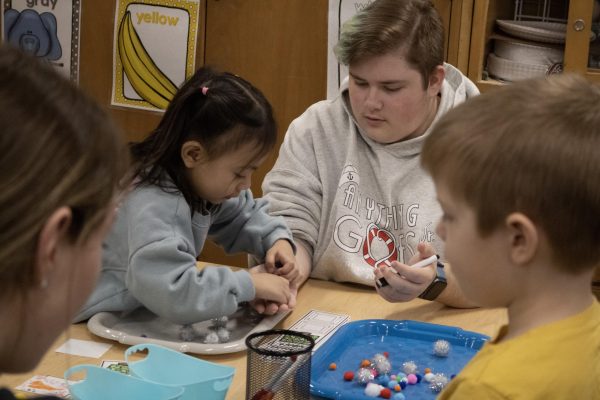Between the white lines: cocaine trickles down from college life
February 13, 2018
Over the distraction of blaring music and party banter, senior Lucy Collins* notices something suspicious. Some of her friends are gathering in the basement bathroom. She sees her friends reenter the chaotic party scene one by one; in the moment she doesn’t think anything of it. Later on that night, Collins learns that they were using cocaine.
According to the National Institute on Drug Abuse (NIDA), cocaine is a “powerfully addictive stimulant drug”, and is classified as a Schedule II drug, meaning it has a high potential for abuse. But in certain situations, it can be administered by doctors as a form of pain relief or anesthesia. As a street drug, cocaine appears as a fine, white, crystalline powder, and can either be injected or snorted, according to the NIDA.
Todd Nogard*, class of 2017, says he had his first encounter with cocaine during his freshman year at a party on his college’s campus. He explains how he did not expect to see the drug at the party, although he was not surprised that students were using it. Adults aged 18 to 25 years old have a higher rate of cocaine use of any other age group with 1.4 percent of young adults reported use of cocaine in the past month, according to NIDA. According to Nogard, he first tried the drug in Oct. of 2017.
Although Nogard still decided to try cocaine, he says he had researched the drug and its effects on the body prior to the experience which gave him more perspective on how dangerous the drug is.
“[Educating myself about cocaine] made me more aware of how hard of a drug cocaine is,” Nogard said. “It didn’t really deter me from not wanting to do it but it did deter me from making it a habit because having a coke habit could definitely destroy your life.”
Though Nogard says he didn’t notice a prevalence of the drug at South during any of his four years, patterns have shifted and cocaine has started to become a drug of choice for some South students this school year, according to senior Sylvia Schumann*.
“[Cocaine] has kind of started to trickle down [from college] into high school because a lot of high school kids are friends with people in college that do it,” Schumann said. “It’s just so intertwined that it’s just eventually [bound] to trickle down into the high school setting.”
Senior Tyler Rogers* remembers the promises he made to himself freshman year, insisting that he would refrain from smoking cigarettes or drinking alcohol throughout high school. However, according to Rogers, he found himself experimenting with cocaine for the first time this past summer at Country Thunder despite feeling momentarily anxious before using the substance.
“We were at this campsite and [my older friend] went into this trailer, walked out and kept rubbing his lips,” Rogers said. “He was playing with his nose and rubbing his gums. [He said], ‘I just did a bunch of coke.’ I … didn’t look down upon it because that’s what that grade did. … He’s [asked], ‘You want some?’ and … then I did a line in the trailer and then I just felt like the king of the world.”
According to Rogers, he has used the drug at Country Thunder, this year’s Homecoming and on Halloween, but he claims he does not suffer from an addiction to cocaine. Rogers explained how access to the drug is not difficult for high schoolers who share relationships with older students.
Social worker David Hartman manages cases of substance abuse among the student body and explains the protocol he takes when faced with these situations when students are using cocaine for example. He says that because cocaine is such an addictive drug, cases are handled with a heightened focus on the student’s wellbeing.
“[Cocaine] is a very, very scary and addictive drug,” Hartman said. “And so I think my instinct clinically is to be more safe than typical. In other words, [if a student came in and said they were doing cocaine] I probably [would have] recommended some type of place to get an evaluation for level of treatment care, [which] can be pretty significant.”
“[My older friend] texted me and was like, ‘Yo, you guys want anything for Homecoming?’ and I was like ‘What do you mean?’” Rogers said. “He [offered], ‘molly, acid, coke’ and I [said] ‘Okay’. And then I asked and everyone in the guy friend group [ and they all agreed], ‘Yeah let’s do [coke], why not?’”
According to Health teacher Chrissy Zagorski, the health unit surrounding substance use takes a large focus on hard-drug abuse, given the rising opioid-epidemic in America. Zagorski explains how the curriculum tailors itself to educate students about the most abundant drugs in the community, which she says is performed most effectively when the teachers are informed about drug patterns in the community.
“I think the fact that we’re having this conversation [about cocaine] is very helpful for me and my other co-teachers for Health because I want to go back to them and have this conversation now,’ Zagorski said. “This is how [material] gets implemented. This is how we raise awareness with different [drug patterns]; when we are informed. It’s kind of hard when [we] don’t know exactly what’s going on. … So now I think it’s definitely going to be a conversation.”
According to Zagorski, even one experience using cocaine can be detrimental to the well-being of a user.
“Everything you do is going to affect you either physically, mentally, emotionally or socially,” Zagorski explained. “The consequences are not always going to be black and white, it’s kind of a spiraling effect. What kids don’t understand with a lot of the drugs [like cocaine] is you can become addicted after just one use. Your dopamine levels in your brain now are used to whatever level you’re taking and you need more and more and more to feel that dopamine surge in your brain levels and kids seek out whatever they can to chase that high.”
According to Sgt. Jim Foley, Glenview Police Department spokesperson, cocaine use in Glenview has been more common among adults over 18. Foley explains how there has been very few ‘Possession of a Controlled Substance’ arrests involving cocaine, the charge they would generally use to take people into custody.
Principal Dr. Lauren Fagel says the school provides assistance for those students who use illegal substances such as cocaine, but outside agencies are also a crucial factor in helping students.
“[Possible forms of treatment] could be regular meetings with the social worker,” Fagel said. “There are sometimes groups of students where social workers will lead counseling groups that could be related to substance use or abuse. Mostly, our own staff would be referring kids and families to local agencies and primarily, we work with Peer Services, Youth Services in Glenview and Northbrook and Rosecrans.”
While Rogers has enjoyed the effects of cocaine, saying its effects are about ten times those of Adderall, he recognizes the dangers of cocaine use. Although he did not seek help from the school or community services, the moment when both his teammate and younger brother confronted him about his cocaine use, he realized that his habits needed to change.
“I went in kind of a downward spiral [during] Homecoming, around that time, and it was kind of freaking [out] people who I was close to,” Rogers said. “And they were like ‘Listen, you need to get help, you need to stop this.’”
According to Hartman, such cases are brought to his attention in one of the two following ways: students admit they need help or the school learns a student has the illegal substance on hand. Fagel says once cases are brought to the attention of South, those students who were caught face consequences.
“Our Board Policy 8460 outlines the consequences for students who are found to be in possession of, under the influence of, distributing or selling any illegal substance,” Fagel said. “A first offense results in a suspension and a requirement to get a drug and alcohol assessment at an outside agency. If the student doesn’t comply with that … they could be recommended for expulsion. A second offense is typically a recommendation for expulsion of some length which means you lose the chance to get to come to Glenbrook South and would have to continue your high school education at a different facility.”
Dean Ronald Bean says consequences differ depending on how a substance abuse case is brought to the attention of the school.
“We are still trying to get people help even if we catch them making a poor choice, but if people reach out to us and say they have concerns about themselves or about a friend, then we deal with that strictly through Student Services and there are no school consequences [which would have been] a suspension,” Bean said.
According to Bean, Section B of the Code of Conduct, which references Board Policy 8460, lays out the specific consequences regarding a student’s participation in sports or extracurriculars. He says that the consequences can be minimized under the Code of Conduct if a student sees a Dean for help or guidance.
“What the Code of Conduct says is that … [for example] if we catch a student smoking marijuana and they play badminton [in] their first offense, they lose 20 percent of their season,” Bean said. “If a student comes in and says, ‘I was at a party this weekend and I made a really poor choice and I drank alcohol and I’m on the badminton team,’ then instead of losing 20 percent, they’d lose 10 percent of their season.”
Despite the active role that the school and administration play in disciplining drug use, Nogard says that he does not believe it is anybody else’s responsibility to monitor what goes into his body.
“I don’t think that anybody has the right to tell anybody else what they should or shouldn’t put in their body and that includes the government and people around you,” Nogard said. “I think people should be allowed to put whatever they want into their body even if it’s not necessarily good for you.”
Even with the consequences in place, Schumann says students continue to use cocaine. She recalls one particular moment in class this school year where one of her peers pulled out a small baggie of what appeared to be cocaine in the middle of class.
Nogard says one of the only things holding him back from using cocaine is the price. He says that one gram of cocaine costs about $75, a price that he cannot always pay.
Collins, however, believes that a factor in the rise of cocaine use has to do with the fact that many students work a job and/or receive some type of money from their parents. She believes that parents play a role in enabling students to purchase an expensive drug like cocaine.
“With the community that we are in, the parents make [money] so available to their kids,” Collins said. “For me, my mom would give me a hundred dollars if I asked for it, but I also work a job so I have money to afford [a drug such as cocaine] if I wanted to, just like any other kid that could if they wanted [cocaine].”
Senior Jesse Simmons* explains that money did not play a role in his accessibility to cocaine. He says he got cocaine from one of his friend’s older brothers who deals it. Although Simmons has only done cocaine once, he recalls the night he tried it with his friends and how he felt extremely energetic and awake.
“I was hanging with my friends and one of their brothers was a coke dealer,” Simmons explained. “And he offered us some and I thought to myself, ‘I might as well try it one time, … just something small’. Overall, the experience wasn’t too negative but I could see how people could fall into a pitfall of abusing the substance. I have not done it since but basically, the entire time, we were all energetic and having a good time. By the end of it, when I got home, I cleaned my room out to the fullest extent which was kind of a positive side.”
Hartman explains how the harm in trying a drug as addictive as cocaine is that after the first time, the user is constantly trying to re-reach that initial feeling of energy. He says that the danger of a drug like cocaine is how quickly someone can get hooked on it before even realizing what they are doing.
“Cocaine is a beast of a drug because you absolutely feel invincible,” Hartman explained. “Whether you’re depressed and you take it or you’re feeling good already and you take it, you have this invincibility, this euphoria and you can stay up all night. It’s a powerful, powerful agent, but then you crash the next day and it just gets harder and harder to say no. It’s an amazingly addictive drug.”
* Names have been changed
Sophie Vick contributed an interview to this report.












